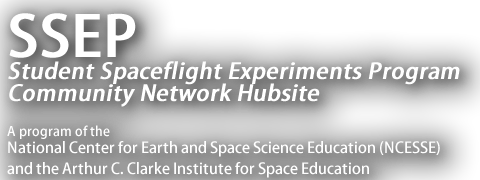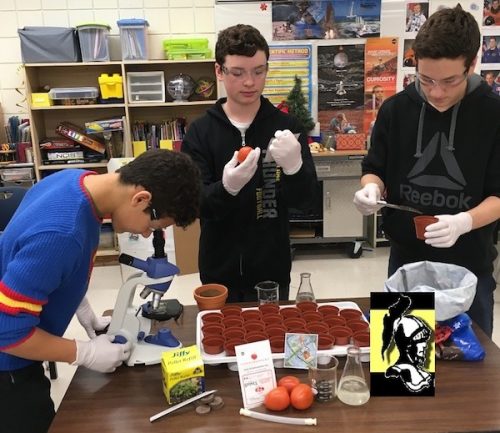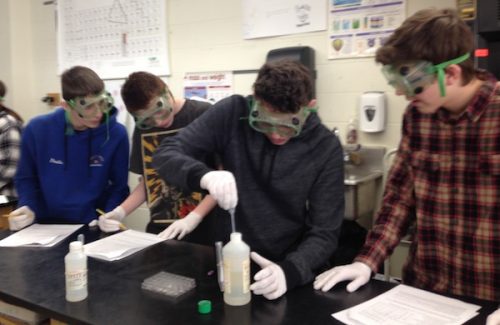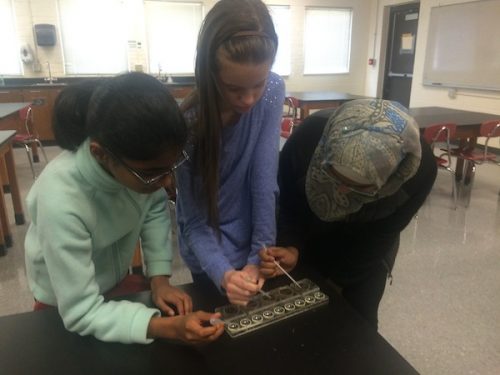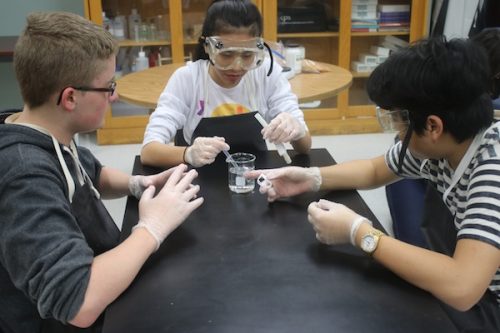The Student Spaceflight Experiments Program is proud to report that there were a total of 1,959 proposals submitted from student teams across the 21 communities participating in Mission 11 to ISS. Of those, 913 proposals were forwarded for review by Step 1 Review Boards in each of the communities. Each Step 1 Review Board selected up to three finalist proposals, which were submitted to the National SSEP Step 2 Review Board.
On December 5 and 7, 2016, the Step 2 Review Board met at the Smithsonian National Air and Space Museum, reviewed all 61 finalist proposals, and selected one proposal to fly for each community, for a total of 21 flight experiments. By December 16, 2016, the National Center for Earth and Space Science Education and the Arthur C. Clarke Institute for Space Education formally notified each community of their selected flight experiments.
It is noteworthy that the 1,959 proposals received reflected a total of 9,870 grade 5-16 students fully engaged in experiment design.
All 61 finalist experiment teams, along with descriptions of their proposed flight experiments, are provided below. You are also invited to meet the SSEP Step 2 Review Board members for Mission 11 to ISS.
Congratulations to the nearly 10,000 students and their teachers participating in Student Spaceflight Experiments Program Mission 11 to the International Space Station.
Quickly Scroll to Individual Communities
- Coquitlam, British Columbia, Canada
- Stonewall, Manitoba, Canada
- iLead Consortium, California
- North Hollywood, California
- Santa Monica, California
- Vista, California
- Bridgeport, Connecticut
- East Hartford, Connecticut
- Hillsborough County, Florida
- University System of Maryland, Maryland
- Fitchburg, Massachusetts
- Galloway, New Jersey
- Springfield, New Jersey
- Waterford, New Jersey
- Rochester, New York
- Concord, North Carolina
- Knox County, Tennessee
- Burleson, Texas
- Lewisville, Texas
- Pharr, Texas
- San Antonio, Texas
1. Coquitlam, British Columbia, Canada
Jump to Coquitlam’s Community Profile
SELECTED FOR FLIGHT:
The Effect of Microgravity on Fly-Ash Concrete used in Building Structures
Grade 12, Riverside Secondary School, Coquitlam School District 43
Co-Principal Investigators: Alexa Durand, Brenda Shen
Teacher Facilitator: Devon Ross
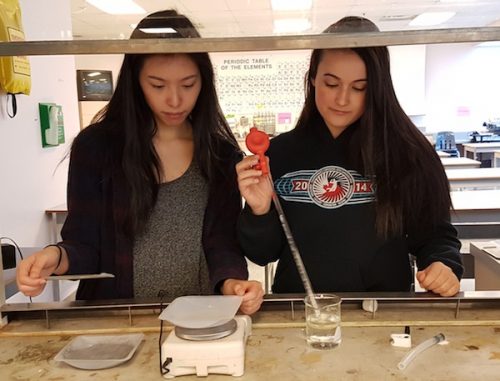
Alexa Durand and Brenda Shen (Grade 12 students at Riverside Secondary in Port Coquitlam, British Columbia) conducting their research on fly ash concrete.
Proposal Summary:
Concrete is the most widely used building material and thus would have many applications in microgravity (Chemistry World, 2008). From building foundations to roads, concrete can be found almost anywhere and has the ability to be even more useful than it already is. We propose an experiment to study the effect of microgravity on concrete, specifically concrete created using a mixture based on fly ash. The use of fly ash in a concrete mix reduces the amount of Portland Cement, dramatically cutting the cost as the material is a byproduct of coal production and does not need to be specifically made for concrete (NPCA, 2010). According to the National Precast Concrete Association (2010), fly ash also has many other benefits including greater strength over time, increased durability and increased workability. These benefits alongside the eco-friendly aspects make fly ash the best choice (NPCA, 2010). While small amounts of fly ash are used in most concretes, it generally does not exceed 30%, because of the long curing rate and the need for additional air entraining admixtures (Kompauer, 2016). We would like to test microgravity’s effect on the strength, the durability and the drawbacks previously mentioned. If this experiment shows that fly ash concrete can have greater strength with its drawbacks negated, it would allow for a greater amount of fly ash to be used and help shift the world into a more eco-friendly direction. This also allows for fly ash concrete to be used for constructing infrastructures in microgravity settings.
HONORABLE MENTION FINALISTS:
Effects of microgravity on cell density and biofilm formation of Staphylococcus aureus
Grade 10, Inquiry Hub Secondary School, Coquitlam School District 43
Principal Investigator: Mike Roslikov
Teacher Facilitator: John Sarte
Proposal Summary:
Staphylococcus aureus is an extremely common, gram-positive bacteria among people. An
estimated 20% of the human population are long-term carriers of S. aureus. It forms clusters, is rather antibiotic resistant (even more so in microgravity), and has many other reasons why it is hard for a human body to kill. A paper by NASA scientists studying the epidemiology of Staphylococcus aureus during spaceflight showed that 5 out of 24 culture negative astronauts (21%) came back culture positive. Using genetic fingerprinting, it was found that 4 of these space shuttle astronauts (17%) did not receive the culture from other crew members. Another study published by BioMed Central shows S. aureus grows better in Modeled Reduced Gravity than Normal Gravity using optical density. The purpose of this experiment is to finally confirm and explain the increased virulence of Staphylococcus aureus in real microgravity conditions. Note that in the NASA study, 58% of astronauts were already culture positive before they were exposed to microgravity. Longer exposures to a more viral S. aureus can lead to negative medical consequences like severe infections. These are often treated with amputations, if not resulting in death. Knowledge about the reproduction speeds of S. aureus can possibly help introduce new protocols to battle with the bacteria during long stays in microgravity.
The Effects of Microgravity on the Growth of Saccharomyces cerevisiae
Grade 11, École Dr. Charles Best Secondary School, Coquitlam School District 43
Co-Principal Investigators: Saba Khangholi, Karina Moreno, Sarah Nobrega, Tessa Tennant
Teacher Facilitator: Matthew Last
Proposal Summary:
Our experiment strives to grow Saccharomyces cerevisiae in microgravity compared to
an equivalent sample grown on Earth. This has never been tested in true microgravity, only in
simulations, meaning our experiment would be the most accurate one to date. This yeast that has a divisional process similar to that of the human cell, making it a great model for scientific
research. Data collected from previous scientific experiments has already led to ground-breaking results in cancer research. Unlike human cell samples that require special handling,
Saccharomyces cerevisiae is nonpathogenic, cost effective and easily maintained yeast that is a great alternative. Access to research on Saccharomyces cerevisiae, a unicellular, well-understood eukaryote, can build an understanding of its cell division rates. Not only would microgravity research allow for an enhanced understanding of how the cell division is affected, but if the yeast grows successfully, a variety of nutritional foods may one day be available for astronauts such as bread, bean paste, and B vitamins. It would be more cost efficient to produce these foods and supplements on the ISS rather than to send them up. Exploring the differences in cell division of a sample of Saccharomyces cerevisiae in microgravity compared to one developed on Earth, would provide us with a better understanding of the variables that would affect its growth rate. We hypothesize that the yeast will grow at a higher rate in microgravity based on results obtained in a previous study conducted using a high-aspect ratio vessel bioreactor.
2. Stonewall, Manitoba, Canada
Jump to Stonewall’s Community Profile
SELECTED FOR FLIGHT:
Can Tomatosphere™ tomato seeds germinate on Earth after having been exposed
to microgravity and cosmic radiation for a second time of exposure?
Grade 8, Ecole Stonewall Centennial School, Interlake School District
Co-Principal Investigators: Carter Ives, Graeme Perrie, Adam Stamler
Teacher Facilitator: Maria Nickel
Proposal Summary:
Our proposal is to see if the Tomatosphere™, seeds (which have previously been exposed to
micro gravity and cosmic radiation environment along with entering and exiting Earth’s atmosphere) will grow on Earth after being re-exposed for a second time to similar conditions on board the ISS (International Space Station). This has not been done before with the Tomatosphere™, a second exposure. We chose the Tomatosphere™ seeds due Grade seven science class when we grew them in the spring of 2016 . We would like the experiment to be conducted to see if the growth rate and size of the tomato plant changes due to these environmental changes. We also chose this experiment to expand our knowledge about astronaut health, space agriculture, deep space exploration and habitation on Mars or other planets. We want to learn from our experiment if astronauts and regular humans are to ever perform interstellar travel and colonize multiple planets, if the increased cosmic radiation exposure will improve or not improve upon nutritious food production. This has large applications for nutritious food production on Earth and in space. Our question is Can Tomatosphere™ tomato seeds germinate on Earth after having been exposed to microgravity and cosmic radiation for a second time of exposure? Our hypothesis is that the Tomatosphere™ seeds from space for the second time, will germinate taller and larger plants. As well, they will germinate faster than the ground truth Tomatosphere™ seeds that have not been exposed to those same conditions.
HONORABLE MENTION FINALISTS:
Will Microgravity and Radiation Affect the Growth, Development, and Breakage of DNA Clusters of Artemia Salina Cysts
Grade 8, Ecole Stonewall Centennial School, Interlake School District
Co-Principal Investigators: Bailey Georgison, Ashley Gobeil
Advisors: Henry Gerow, Troy Gobeil, Doug Wakkinson
Teacher Facilitator: Maria Nickel
Proposal Summary:
We want to see if the microgravity and cosmic radiation of space will effect the growth, development of the cysts, and breakage of DNA clusters the artemia salina cysts. Our project is testing to see whether radiation and microgravity will effect the growth and development of artemia salina (brine shrimp) cysts, along with the breakage of the DNA clusters. We will have one group of 10.6 grams of cysts on the shuttle and one group of the same amount on Earth in controlled conditions. After the unhatched cysts come back down to Earth, we will allow them to hatch, along with the control group. The cysts will be cultured on Earth as the estimated time for the cysts to reach full growth is 14-21 days They will be in the same environment, and have conditions controlled, like amount of sunlight and oxygenation. We will see if the exposure to radiation and microgravity affected the test group. We will compare the length and weight of the shrimp, and how many survived the radiation and microgravity exposure, and use a high powered electronic microscope to examine the DNA clusters, to see if they have been damaged. The cysts will not be hatched in space. We want to do this because it will tell us what to expect of small living organisms, to see how the cysts will react, and to see if they could be used for food during a long-duration space flight, or whatever purpose they may serve.
Will Yeast Bloom in Microgravity without Heat?
Grade 8, Ecole Stonewall Centennial School, Interlake School District
Co-Principal Investigators: Kylee Leathwood, Brianna Waldner
Teacher Facilitators: Corinne Johnson, Maria Nickel
Proposal Summary:
Will yeast bloom in microgravity? We would like to send out experiment into space because if the yeast does bloom astronauts will be able to bake bread in space. If they could bake bread there would always be fresh bread, buns, ect. in space and it would expand the food groups astronauts can eat while in space. For our spaceflight experiment we are going to split our test tube in three, the first section will be empty space because if the yeast blooms it will need more space because the foam will rise. The second section will have yeast. Finally, the third section will be a mixture of sugar and water. If we in habit other planets in the future this will help us because we will be able to make bread, there will be even more important than having it on the ISS because it would be impossible to send fresh bread there for the astronauts to eat.
3. iLEAD Consortium, California
Jump to iLEAD’s Community Profile
SELECTED FOR FLIGHT:
Microgravity and Yeast
Grade 6, iLEAD Pacoima, iLEAD Charter Schools
Co-Principal Investigators: Auguste Bacchus, Daniel Herrera, Jack Sidman, Alexii Villamar
Teacher Facilitator: Jacob Drori
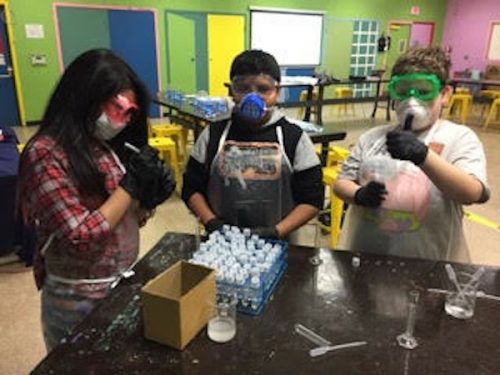
Alexii Villamar, Daniel Herrera, Jack Sidman testing the effects of formalin on yeast cell integrity.
Proposal Summary:
Our group is intending to discover how fast S. cerevisiae grow differently in microgravity than on Earth. Yeast is a simple organism that feeds on things like sugar mixed with water and it produces CO2. Yeast is a fungus used for cooking foods like bread, dough, and alcohol. Yeast has B vitamins and those vitamins help your body convert carbohydrates and fats into protein and energy. Yeast reproduce asexually by budding. Budding is when a parent yeast cell begins to grow, so when the parent cell gets bigger the parent cell’s nucleus divides into two. One of these nuclei transfers into another growing bud, which eventually pinches off and the process repeats. We developed this idea because one of the people in our group thought about yeast, because his father is a chef, and his father had a list about how to make pizza dough, which of course has yeast. We hope to learn if yeast will bud faster in space than on earth due to microgravity. Yeast could be used to make food in space instead of having to bring all of it when leaving earth. This is especially true of foods like bread which won’t typically last long.
HONORABLE MENTION FINALISTS:
The Efficacy of Antibacterial “Biocence” in a Microgravity Environment
Grade 9, Santa Clarita Valley International Charter School, iLEAD Charter Schools
Co-Principal Investigators: Ethan Guthrie, Jaron Steele
Collaborators: Sean Brimigion, Austin Horner
Advisors: Allan Lord, Rich Ulrich, Micro Quality Labs, Inc.
Teacher Facilitator: Rodney Olson
Proposal Summary:
Our experiment will examine the efficacy of antibacterial “Biocence” in a microgravity
environment. Biocence is an all-natural liquid antibacterial, with a successful track record for
eradicating harmful organisms. Biocence has proven effective across all BSL (Biosafety Level)
organisms, including anthrax spores and Bacillis Pumilis. On Earth, Biocence eradicates harmful organisms within thirty seconds of introduction without harm to healthy cells. Given that travel to Mars is close at hand, our goal is to ensure the safety of long-term space travel. If Biocence extinguishes spores in microgravity, it will increase the safety of the participants on any given spacecraft. We feel this is of immense importance, especially considering how Bacillus pumilus was found on eight separate JPL “clean-room” surfaces, and on the ISS itself, and has been shown to be the most resistant to simulations of Mars’ atmospheric UV light and the current antibacterial used, hydrogen peroxide. We will compare Biocence efficacy on Earth and in microgravity. We will use the FME lab #3, which includes three sections: one for Bacillus pumilus spores, one for Biocence and the last for a second segment of spores. This will act as an “in-flight” control, which will confirm the validity of experiment results.
The Effects of Microgravity on Watermelon Seed Germination
Grade 7, iLEAD Lancaster Charter School, iLEAD Charter Schools
Co-Principal Investigators: Jeremiah Childress, Aelan Cohen, Veronica Flores
Co-Investigators: Julian Busby, James Coleman, Lilah Miranda, Ikir Moten, Kaden Newbill, Zion Pate, Ryan Thomas
Advisors: Marcelo Serpe, Dr. Paula Schiffman, Velda L. Thomas, Dr. Paul Wilson
Teacher Facilitator: Rachel Johnstone
Proposal Summary:
Our experiment will be conducted on plant germination. We would like to see the effects of
microgravity on citrullus lanatus (watermelon). Our team picked watermelon because of the
many health benefits it offers. Astronauts face a bevy of physical and mental demands during space exploration.“Isolated from family and friends, exposed to radiation that could increase the lifetime risk of cancer, a diet high in freeze-dried food, required daily exercise to keep your muscles and bones from deteriorating…” (Gushanas, 2016) Our team proposed that watermelon could be a key to figure out a way to sustain a healthy life, help astronauts improve their health while on the ISS, plan for future generations, and colonization in outer space. This led us to our question: What are the effects of microgravity on the germination of citrullus lanatus (watermelon)?
4. North Hollywood, California
Jump to North Hollywood’s Community Profile
SELECTED FOR FLIGHT:
Hydroponics in Microgravity
Grade 8, Oakwood School
Co-Principal Investigators: Finn Flackett-Levin, Koa Lee, Noah Mack
Teacher Facilitator: Melanie Magdaleno
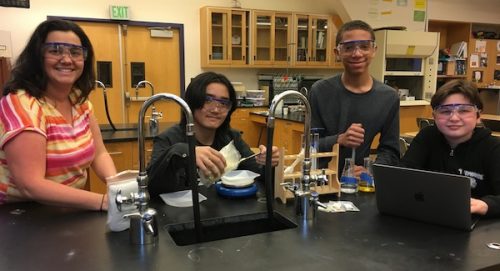
Teacher Melanie Magdaleno working with her students Koa Lee, Noah Mack, and Finn Flackett-Levin. The North Hollywood team is fine tuning their hydroponic micronutrient experiment.
Proposal Summary:
In our experiment, we plan on figuring out what effect gravity, or rather the lack of gravity, has on the amount of root hairs grown on plant roots. Plant roots play a major role of getting nutrients from the outside of the plant to the insides, which would then help it grow. We will be germinating lettuce hydroponically, because hydroponics are easier to manage in microgravity than normal soil, and lettuce grows easily in hydroponic environments. We will be using 2.5 – 2.8 ml of the nutrient solution per volume, and we will also be using 3 lettuce seeds. In volume 1, we will place the lettuce seeds, and in volumes 2 and 3 we will put the hydroponic nutrient solution. We will simultaneously be conducting this experiment on earth as a control within the effect of gravity. When the experiment returns to earth, we will examine both of the germinated seeds under a microscope to count the differences in the number of root hairs both seeds have. The knowledge we gain from this will help us in the near future if and when we need to grow food on longer space missions.
HONORABLE MENTION FINALISTS:
The Testing of Lima Bean Growth Speed In and Out of Microgravity
Grade 7, Oakwood School
Co-Principal Investigators: Sophia Gibgot, Miller Ontiveros
Teacher Facilitator: Kari Bosworth
Proposal Summary:
Our experiment is testing the growth of lima beans in microgravity. We chose this because as the world begins to more and more branch out into space, astronauts will need both food and oxygen. Lima beans turn carbon dioxide into oxygen, so in the event of entering an environment without much oxygen, something necessary to human survival, lima beans will be very useful, and with their small size, we can send them to space in large amounts, and, if they can grow in microgravity, grow them in space as well. They are also a great food source, and since lima beans will already be sent up to space because of their oxygen capabilities, we will not need to spend extra money sending up food, as lima beans are edible and healthy. We will send one lima bean into space with soil for it to stay planted in, water that will be slowly added in during it’s time at the ISS, and saltwater to stop growth when it leaves microgravity. We will also grow an identical lima bean on earth, with everything the same except for microgravity. When comparing the two at the end, we will be able to see if lima beans can grow better, or even at all, in microgravity, compared to on Earth.
Do Commercial Disinfectants Affect E. coli Differently in a Microgravity Environment?
Grade 7, Oakwood School
Co-Principal Investigators: Kaipo Lee, Gabrielle Mostow
Teacher Facilitator: Kari Bosworth
Proposal Summary:
Our team proposes to answer the question: Do disinfectants such as those found in products like Lysol® Brand Concentrate Disinfectant inhibit the growth of E. coli in a microgravity environment? We will measure the growth rate of E. coli with a standard commercial disinfectant on Earth, and discover if the results differ in microgravity. The purpose of this experiment is to observe if E. coli strains are more resistant to the disinfectant in microgravity. Because previous experiments have shown that E. coli in microgravity had augmented biofilm production leading to improved adherence, we believe commercial disinfectants would have a weakened killing rate (Microbe Wiki). This experiment would provide information on protection against bacteria in microgravity. Commercial disinfectants are widely used to prevent disease, and information on their effectiveness in microgravity can be used to further advancements on sickness prevention and sanitation in space.
5. Santa Monica, California
Jump to Santa Monica’s Community Profile
SELECTED FOR FLIGHT:
The Effect of Microgravity on the Rate of Fermentation in Saccharomyces cerevisiae
Grade 8, Lincoln Middle School, Santa Monica Malibu Unified School District
Co-Principal Investigators: Alexander Chopra, Kenneth Christmas III, Zachary Jacobs, Samuel Kohn, Noah Sakkour
Teacher Facilitators: Carol Wrabel, Gretchen Gies McLaughlin

In the final hours of proposal writing, Alexander Chopra, Casey Christmas III, Zachary Jacobs, Samuel Kohn, and Noah Sakkour are calculating, questioning, and critiquing.
Proposal Summary:
The question being proposed is whether or not microgravity on the International Space Station affects the quantity of ethanol produced from yeast fermentation compared to the amount produced on Earth. Fermentation is a process in which a sugar solution containing yeast as catalyst is turned into alcohol (ethanol) (GCSE CHEMISTRY). With ethanol being a cleaner energy source, it could cut down on pollution leading to cleaner atmospheres. This experiment could raise the possibility of using yeast as a catalyst for rocket fuel or as an energy source during space expeditions. To answer the question, the experiment must be tested in the Fluids Mixing Enclosure (FME) while on the International Space Station’s microgravity atmosphere. The contents of the first and second sections of the FME tube include the yeast (Saccharomyces cerevisiae), and the solution of Wyeast Nutrient Blend, dextrose (corn sugar), mixed with distilled water. The third and final section of the FME tube contains sea salt. The yeast and the solution will be mixed and the sugar will allow the yeast to ferment and the nutrients will allow for the yeast to survive. After two days, the third section will be unclamped allowing for the salt to kill off the yeast and stop the fermentation process. The amount of ethanol produced will then be measured. Being able to produce ethanol more efficiently in the microgravity environment could allow the use of ethanol as an alternative, less costly, and more efficient fuel source that could enhance future space exploration.
HONORABLE MENTION FINALISTS:
The Effect of Microgravity on the Eradication of Escherichia Coli Using Vinegar (5% Acetic Acid)
Grade 8, Lincoln Middle School, Santa Monica Malibu Unified School District
Co-Principal Investigators: Theodore Berger, Gabrielle Odoom
Co-Investigators: Ryan Lee, Kae Tanabe
Collaborator: Olivia Kramarsky
Advisors: Christopher Berger
Teacher Facilitator: Marianna O’Brien
Proposal Summary:
Harmful bacteria are evolving, becoming ever more resistant to antibiotics. Furthermore, studies on the ISS have demonstrated that bacteria become stronger in space, multiplying up to twice as fast as on Earth as well as tripling in virulence. For these reasons, we must find new, better ways to counteract pathogenic microorganisms. Our group is interested in testing the efficacy of white vinegar on the elimination of bacteria, specifically the Escherichia coli, K-12 strain. We hope to analyze, precisely, how the vinegar’s ability to kill bacteria is altered by microgravity. This experiment is not only limited to insight about vinegar. Additionally, it will give us insight on how common disinfectants similar to vinegar change as a result of microgravity. After the experiment returns from its journey to the ISS, we hope to use a spectrophotometer, a device used to determine turbidity by measuring the amount of light that passed through a suspension of cells. If more bacteria cells are present, it is more turbid, indicating that less light is passing through the suspension medium, due to the omission of the remaining light by the bacterial colony. We will then apply certain equations to ultimately find the extinction coefficient of the solution, or how much of the bacteria colony died or grew. The results obtained from our FME will be used to determine how microgravity impacts vinegar’s effects on eradicating the bacteria, thereby showing whether or not white vinegar is a viable solution to use against bacteria in a microgravity environment.
The Production of Termite Biofuel in Microgravity
Grade 8, Lincoln Middle School, Santa Monica Malibu Unified School District
Principal Investigator: Benny Szeghy
Co-Investigators: Dylan Burger, Jack Mickel
Collaborator: Donny Szeghy
Advisor: Marian Polski
Teacher Facilitators: Marianna O’Brien, Verian Wilson
Proposal Summary:
We will be sending termites up to the ISS to measure how much biomethane they can produce. When termites eat, the bacteria inside of their digestive tract turns cellulose into methane, a type of biofuel. Cellulose, a polysaccharide, is the main component of plants and plant-based products. If it is possible to easily produce methane in space, waste could be used as an energy source or rocket propellant in future space colonies. When our experiment is in space, the termites will be released to a piece of wood. When it is brought back down, we will measure to see how much of the wood was consumed by taking the mass and comparing it to the ground truth experiment. We will also take a cross section from the wood sample to see if the termites gravitated towards a certain part of the wood. We will be using a methane atmosphere detector to calculate how much methane the termites produced, and an electronic masser to determine the mass of the wood before and after. The last necessary tool for our experiment is our own eyes to see where the termites ate the wood. Using methane is a way cleaner energy source for our environment and using termites to produce the methane can be very helpful for us now and in the future.
6. Vista, California
Jump to Vista’s Community Profile
SELECTED FOR FLIGHT:
Can Dugesia japonica Regenerate in Microgravity through the Use of Stem Cells?
Grades 6-8, Vista Magnet Middle School, Vista Unified School District
Principal Investigator: Evie Currington
Co-Investigators: Isabella Ansell, Isabel Camacho, Charlotte Currington, Sydney Wagner
Teacher Facilitators: Stephanie Sanchez, Sam Stavis, Christine Bartee
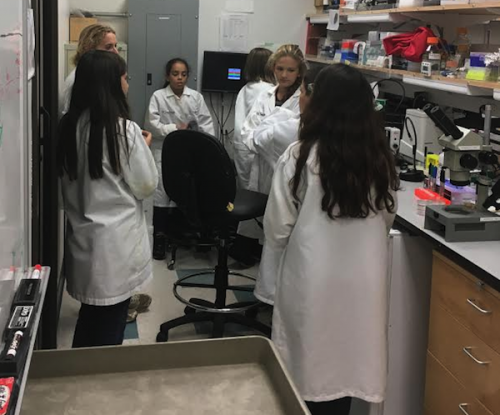
SSEP Student Researchers, Evie Currington, Isabel Camacho, Charlotte Currington, Sydney Wagner and Isabella Ansell work on their experiment at a UCSD laboratory.
Proposal Summary:
Our question is ‘Can Dugesia japonica planarian worms regenerate heads while in microgravity through the use of stem cells?’ We will send ten Dugesia japonica tails into space. Our objective is to compare the regeneration of Dugesia japonica on Earth to their regeneration in microgravity. Since Dugesia japonica regenerate, scientists can look into how they regenerate and in the future find out how to regenerate human body parts. We will quantify the size and the number of eyes and the head development for the two auricles (the tips on the sides of the head) and both light sensing eye spots called ocelli. Our hypothesis is if we send ten Dugesia japonica tails into microgravity, then the planarian worms will not regenerate because the stem cells in the Dugesia japonica will be affected. If the Dugesia japonica fully regenerate, then in the future scientists might be able to regenerate astronauts’ bone structure or muscle mass while they are on the ISS.
HONORABLE MENTION FINALISTS:
Germination Of Seeds In Space (GOSIP)
Grade 9, High Tech High North County, San Marcos Unified School District
Co-Principal Investigators: Anil Kraft, Sydney Lorton, Sofia Mertz
Teacher Facilitator: Kurt Schwartz
Proposal Summary:
Our experiment will be focusing on the germination of three Solanum lycopersicum seeds (tomato seeds) in microgravity. We are curious if the plants will germinate, and what direction it grows with little gravity. It will be planted in a Type 2 FME tube and wrapped around in a paper towel which can transfer water to the seeds. The paper towel will be rolled up and act as a long “tube” to connect the seeds to water, and will need to complete We will have a clamp cutting off the water and the hydrogen peroxide supply until needed. The water and hydrogen peroxide will be mixed to stop the plant from molding. When instructed, we will have the crew unclamp and reclamp the tube with enough time to transfer the water/hydrogen peroxide through the paper towel. To insure the water will reach the paper towel, we will also need to have the tube shaken for about 3 seconds. We will see if the plant germinates properly, or if it will germinate at all.
How Will A Ruminant Blood Mixture React to A Microgravity Environment?
Grade 9, High Tech High North County, San Marcos Unified School District
Co-Principal Investigators: Elisabeth Dukes, Breanna Jones
Teacher Facilitator: Dr. Cate Challen
Proposal Summary:
Blood’s been sent into space before so what makes our experiment idea unique? We want to test the boundaries of ruminant (cow) blood to see if it can benefit the process of blood transfusions, creating synthetic blood or any other possibilities that can help the human race. There are eight hundred different ruminant blood types and eleven major blood groups. Humans and ruminants have similar blood types. We want to send ruminant (cow) blood types J and B into the microgravity environment because these blood types are the most similar to human blood depending on the Rh (Rhesus) levels. There are lots of different factors that go into ruminants blood and how it relates to human blood but we believe in the breakthrough of using ruminant blood that’s put in microgravity conditions being used for synthetic blood. We would also like to test how the blood will generally react. Will it change color? Can it be used effectively? Will the blood types reject each other? These questions will enable future research on how to improve blood transfusions in space and on earth. This experiment will also allow a further understanding about ruminant blood and different ways of using it. In conclusion, we would like to experiment the mixture of ruminant blood so we can further analyze its true potential of what it can truly be used for, we believe that there is more to ruminant blood and it can serve more purposes than meets the eye.
7. Bridgeport, Connecticut – Fairchild Wheeler Interdistrict Campus
Jump to Bridgeport’s Community Profile
SELECTED FOR FLIGHT:
Microgravity’s Effect on Immune System Response of Model Species: an interaction between Daphnia magna and Pseudomonas aeruginosa
Grade 12, Aerospace & Hydrospace Engineering School at the Fairchild Wheeler Campus, Bridgeport Public Schools
Co-Principal Investigators: Kiana Laude, Raysa Leguizamon, Jucar Lopes, Uchenna Oguagha
Teacher Facilitators: Lucas Fatsy, Zachary Garoffolo, Cliffton Price
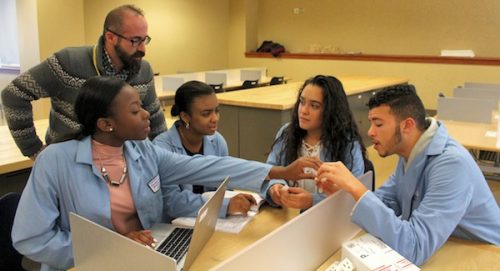
Teacher Luke Fatsy with students Uchenna Oguagha Kiana Laude, Raysa Leguizamon, and Jucar Lopes, all of Fairchild Wheeler Interdistrict Magnet School work on setting up their experiment for the International Space Station.
Proposal Summary:
With the expansion of space exploration, living in outer space is no longer a dream. Even though there has been ground breaking research, there are still many unknowns that are essential to living successfully in outer space. The effect of microgravity on the human immune system response is currently unknown. After astronauts have been exposed to microgravity for long periods of time, their immune system does not generate the appropriate responses to threats. This project will explain the interaction between the immune system of Daphnia magna and the bacteria Pseudomonas aeruginosa in a microgravity environment. The experiment will take place aboard the International Space Station (ISS). Since this experiment contains a BSL level 2 bacteria, all preparations will occur in a BSL level two certified laboratory. The D. magn will be exposed to the bacteria for 3 days in space before being sent back to Earth for testing. The hemolymph of the D. magna will be tested for a change in the protein levels prior to the space experiment and after the experiment has returned to Earth. These results will give insight to how microgravity influences the interaction between bacteria and the immune system.
HONORABLE MENTION FINALISTS:
A Novel Approach to Bioremediation of High-nitrate Concentrations in Water Supply with Thiobacillus denitrificans: An Application to Urine Purification in Zero Gravity
Grade 12, Aerospace & Hydrospace Engineering School at the Fairchild Wheeler Campus, Bridgeport Public Schools
Principal Investigator: Anubhav Dhar
Teacher Facilitator: Lucas Fatsy
Proposal Summary:
High nitrate concentrations in human water supply are detrimental to both humans and marine life, as ingestion of these substances in excess causes a wide variety of internal complication and occasionally, fatalities. Aboard the International Space Station (ISS), where 93% of astronauts’ drinking water is filtered from mostly urine, nitrate contents in the filtrate have shown concentrations up to four times the potable concentration standard, causing great concern for safety of astronauts ingesting quasi-purified water. This study investigates a novel method of bioremediating high nitrate concentrations in human urine, involving the attenuating agent Thiobacillus denitrificans to reduce nitrates through denitrification. The bioremediating bacteria will be activated by a nutrient solution, allowed to consume nitrate sample of 150mg/mL, and effectively killed off by the bactericidal agent Polymyxin B sulfate. Data collection will involve utilizing an in house spectometer to measure nitrate removals by the bacteria, and to also calculate the bacteria’s efficacy as a bioremediating agent. Gathering data from relevant studies, 59% of the original nitrate concentration is intended to be reduced by T. denitrificans. Past studies have produced hazardous byproducts in the effluent as a results of catalysts, and little to no research has been completed on bio-filtration of urine. This study fill the gap of denitrification of urine purification, with strictly the use of T. denitrificans, contributing to the lack of research in this area both on Earth and in microgravity.
The Effects of Microgravity on Antibiotic Resistance within Salmonella Typhimurium
Grade 12, Fairchild Wheeler Interdistrict Magnet High School: Biotechnology, Bridgeport Public Schools
Co-Principal Investigators: Ashley Andino, Teya Silas
Teacher Facilitator: Melissa Bryll
Proposal Summary:
Food-born illnesses have been a very common problem amongst the human population. One of the most prominent food-born illnesses found today is known as Salmonella Typhimurium. This bacterium if found in 1 in 6 Americans every year causing a wide spectrum of multiple disease. Salmonella has caused 28% of deaths amongst all food-born illnesses. Streptomycin and Tetracycline are both antibiotics used for different purposes, and have been found to treat the symptoms of Salmonella victims. The purpose of the experiment is to not only explore the treatment options on earth, but also in a microgravity environment. It seems to be a popular question; if anything were to happen on Earth, where would humans go? There are multiple factors to success of human development on Earth, but food growth is one. How can food be produced in space? How severe is bacterial growth in a microgravity environment? Is food growth in space safe for consumption? Even though NASA is growing produce in a space garden, this experiment is more specific by exploring the effect anti-gravity has on antibiotics, Streptomycin, to treat food-born illnesses like Salmonells typhimurium.
8. East Hartford, Connecticut
Jump to East Hartfords’s Community Profile
SELECTED FOR FLIGHT:
How does Microgravity Affect Algae Growth?
Grade 8, CREC Two Rivers Magnet Middle School, Capitol Region Education Council (CREC)
Co-Principal Investigators: Kassidy Gagnon, Jack McCann, Andrew Niemczyk, Angel Soto, Kieran Yanaway
Teacher Facilitator: Kennan Poulakos
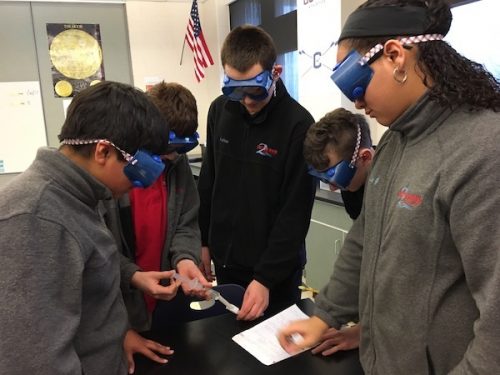
Students test volumes in preparation for the launch of their mini-lab testing algae growth in microgravity.
Proposal Summary:
We are investigating whether algae growth is affected by microgravity. We believe that algae will not be affected in microgravity. The conditions of algae growing would not be considerably changed, as microgravity would simply result in floating globules of algae. This information will be imperative to future space travel and space tourism, as algae can be used as both a fuel source and a food source, meaning that we would be able to grow our own food and fuel while on a space flight. Algae can be reproduced very quickly and only needs sunlight, or for heterotrophic algae, forms of energy like sugar. Algae are also useful to purify air and wastewater, as well as creating energy (Seydel, 2016). This experiment will be conducted to successfully gain information on how algae would be produced on something such as a space station or rocket. We will grow heterotrophic algae in the tube using sugar as a food source mixed with water. These chemicals will cause the tube to grow algae inside it and we will use a preservative chemical (Formalin) to preserve the algae and chart the results. Once we have both tubes, we will measure the amount of algae in the water of each tube, so as to see if regular growth methods of
algae can be used in space.
HONORABLE MENTION FINALISTS:
How does Microgravity Affect the Feeding Habits of Dugesia Tigrina?
Grade 8, CREC Two Rivers Magnet Middle School, Capitol Region Education Council (CREC)
Co-Principal Investigators: Chris Ferguson, Lilliana Perez, Xavier Rivera, Jazmyn Soto-Alston, Kieran Yanaway
Teacher Facilitator: Kennan Poulakos
Proposal Summary:
We expect that if planaria are placed in microgravity, the process by which they feed will be unaffected. The medical procedures of today have advanced drastically since a few years ago. However, we have not accomplished bodily regeneration. The accomplishment of such a procedure would be a landmark in history. The planarian flatworm plays a huge part in the research of human regeneration (Departament de Genètica). If the planarian feeding habits are affected in space, then their regenerative capacities may be affected as well. This information may be imperative to know should there be a future colonization of space. If we accomplish human organ regeneration, but this process is affected in space, the result could be catastrophic. This experiment examines how the brown planarian, Dugesia Tigrina, feed in space. We will measure a certain amount of food, and 3 Dugesia Tigrina, and then record the amount of food left over in both tubes. We predict that the food amounts will likely be similar, as the Dugesia Tigrina travel using a slime path, meaning that even in micro gravity they should be able to move freely and eat. Should they be different, we will chart the difference and be able to tell how much microgravity affects the feeding process of Dugesia Tigrina.
How does Microgravity Affect Mouthwash’s Ability to Kill Bacteria?
Grade 8, CREC Two Rivers Magnet Middle School, Capitol Region Education Council (CREC)
Co-Principal Investigators: Tiana Colthirst, Ashley Frazier, Sarah Waggoner
Teacher Facilitator: Kennan Poulakos
Proposal Summary:
In our experiment, we are testing how microgravity will affect the amount of bacteria mouthwash kills. We are testing this because mouthwash is a key factor in keeping good oral health used by millions of people. We think that microgravity will kill fewer bacteria on ISS than on earth. We think this will happen because in space there is 10% less gravity than on earth, so that means that all of the materials will be floating around in the tube and won’t be making as much contact as it would be making if they were on earth. We will be using many materials, such as an extracted tooth, which we will cover in bacteria and will put that in agar; and mouthwash will be used to kill the bacteria on the tooth. When in space, the astronauts will unclamp clamp “A” and shake the tube for 30 seconds, allowing the mouthwash to kill bacteria. They will then unclamp clamp “B” and allow the tooth to go into the other section of agar. When the tube returns to earth, we will see if there are still living bacteria. If there aren’t, that means the mouthwash successfully killed all of the bacteria. If there are some left, then that means the mouthwash did not kill all of the bacteria and it grew in the agar. Depending on the results that we receive from this experiment, we will know if mouthwash will successfully work in space for astronauts.
9. Hillsborough County, Florida
Jump to Hillsborough County’s Community Profile
SELECTED FOR FLIGHT:
Gravitational Force and Mushroom Growth
Grade 5, Lockhart Elementary Magnet School, Hillsborough County Public School District
Co-Principal Investigators: Angelina Jansen, Telvin Mexile
Collaborators: Dominic Battiato, Yasmin Bolen, Abdiel Diaz, Jimmy Jean, Amir Shabazz, Sir Jacob Thompson
Teacher Facilitator: Jane Kemp

Lockhart Elementary Magnet, Tampa, Florida, Student Spaceflight Experiment Program team hard at work replicating their procedures for testing the effect of microgravity on mushroom growth. Left to right: Dominic, Jimmy, Abdiel, Sirjacob, Telvin and Angelina.
Proposal Summary:
The future of space flight will certainly include long trips through space to distant locations in the galaxy or beyond. Space travelers will need proper nutrition including essential vitamins and minerals that are found in fresh fruits and vegetables. Fruits and vegetables are, however,
heavy and extremely perishable and not appropriate for space travel. We are in the process of growing organic oyster mushrooms because they are a variety of mushroom that are high in protein, minerals such as zinc and iron, and many vitamins such as B, D, and C. Our team proposes an experiment that will test mushroom growth in microgravity to determine if mushrooms could be grown and eaten on long trips beyond Earth. Certain types of mushrooms are high in critical vitamins and minerals that support high levels of energy and healthy immune systems in humans. They are also very light weight and, if we are correct, will grow on a very light base. They also grow very quickly and produce an abundance of spores giving them the ability to be a sustainable food source. We propose to test mushroom growth in microgravity to determine if mushrooms would be a viable long distance food source for future astronauts.
HONORABLE MENTION FINALISTS:
Space Ants 2167
Grade 5, Cypress Creek Elementary School, Hillsborough County Public School District
Co-Principal Investigators: Diante Hall, Daniel Harwin
Teacher Facilitator: Monica K. Pedraja
Proposal Summary:
Ants the common creature that have a shorter and more difficult life. We might have seen humans in space, but what about…ANTS IN SPACE! The ant has different needs than humans but then again it might be helpful to them while in space. Ants are very helpful, they help make soil rich with nutrients to help plants grow. Some ants specifically queen ants, worker ants, and harvester ants can live up to 90 days, 6 months, or even a YEAR! Ants can only survive underwater or with no air for about 24 hours because they don’t have lungs they breathe through small holes in their bodies. Ants weigh 1-5 milligrams but can hold about 5,000 times their own weight. Ants have brains but they are small, they are smaller than pinpoints but even though their brains are small they can understand SUPER COMPLEX things. If ants can survive in space they can help the soil and that soil can produce food and other needs the human while in space! So my partner and I have thought of sending our ants in space with 4 ml of ant gel so the ants can make some holes or tunnels and nourish from ant gel. So then when the ants get back we will see if they have survived and changed in any way. With that we can see if it can help us in the future growing of plants.
Space Worms!
Grade 5, Cypress Creek Elementary School, Hillsborough County Public School District
Co-Principal Investigators: Kaylie Brown, Rikki DeOreo, Gaven Torres
Teacher Facilitator: Monica K. Pedraja
Proposal Summary:
Our idea is to send an Eisenias (earthworm) to space. We would send two earthworms with soil and compost for them to eat. We would like to know if earthworms could survive in space for thirty days with no gravity. If earthworms could survive in space this could help NASA to grow food in space. Worms are decomposers and will make compost, and rich soil to help plants grow in space. If earthworms can decompose, survive, and help plants grow in space, they could help make it possible to grow food and have life on other planets. Earthworms decompose, so that means they could also help get rid of all the food, and trash on earth too. This will help stop pollution on earth.
10. University System of Maryland, Maryland
Jump to USM’s Community Profile
SELECTED FOR FLIGHT:
Inhibition of P. Aeruginosa Biofilm Formation with Silver Impregnated Antimicrobial Silicone in Microgravity
Grade 14, University of Maryland College Park, University System of Maryland
Co-Principal Investigators: Stacey Audrey Mannuel, Colton Justis Treadway
Teacher Facilitator: Rachel Manthe
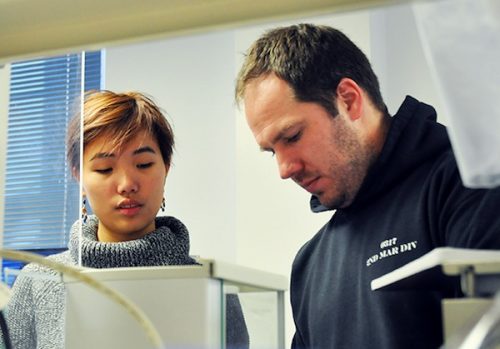
Stacey Mannuel and Colton Treadway (left to right) measure the components of the medium needed for their experiment.
Proposal Summary:
Here we propose a method to comparatively analyze the effect of antibacterial material on the growth of P. aeruginosa biofilm in micro-gravitational conditions. Biofilms are a large concern in the medical field due to its resistance to antibiotics and ability to cause infections. Additionally, they also pose a problem in the maintenance of space instruments and astronaut health. Our team proposes to test the new technology of silver-based antimicrobial silicone rubber by growing P. aeruginosa biofilms on both non-modified silicone and antimicrobial silicone in our FME. P. aeruginosa was chosen because it is a well-studied model for general biofilm formation. Previous research has demonstrated that the lack of physical stresses in microgravity promotes biofilm formation. Though silver-based antimicrobial silicone has been shown to reduce P. aeruginosa biofilm formation by 95% in normal ground conditions, we wish to see how it performs under low-shear conditions that are experienced in space in order to better understand its efficacy as medical implants. Furthermore, we hope that our data will reinforce the current research surrounding space biofilm formation and determine whether or not the ion mechanism of the silver-based antimicrobial silicone can successfully prevent biofilm growth. Upon return from the ISS, the biofilm grown on both the unmodified and antimicrobial silicone will be collected and compared to a ground control experiment via confocal microscopy analysis.
HONORABLE MENTION FINALISTS:
The Effect of Microgravity on Bacteriophage Replication and Infectivity
Grade 14, University of Maryland College Park, University System of Maryland
Co-Principal Investigators: Rushi Challa, Natalie Ivanina
Advisor: Dr. Daniel Nelson
Teacher Facilitator: Dr. Kenneth Frauwirth
Proposal Summary:
Bacteriophages, viruses that infect bacteria, have numerous growing applications that include food/water disinfection, alternatives for antibiotics, and as future models of transportation for CRISPR/Cas9 or other genetic engineering techniques. Our experiment focuses on the principle of sterility in microgravity on the ISS. Previous studies on the ISS have found that a number of bacterial species, including several forms of human microbiota and other environmental bacteria, thrive in microgravity environments. In fact, bacteria are a growing concern and a threat to the sanitation of the ISS, along with the health of the astronauts living in it for a prolonged period of time. Bacteriophages offer an effective and environmentally-friendly approach to disinfection as they are harmless to humans, animals, and plants and efficiently destroy specific bacterial targets. Testing the infectivity rate of bacteriophages in microgravity would allow for a new potential disinfecting technique to be used on the ISS as opposed to traditional chemical disinfectants and expensive newly designed technologies such as plasma (electrically charged gas) equipment. Understanding the effect of microgravity on replication of bacteriophages would allow for further testing and creation of bacteriophages that could target well-known bacterial species that are found on the ISS. This experiment could also lead to numerous other applications such as using bacteriophages in place of antibiotics for bacterial infections and exploring the field of genetic engineering in microgravity environments.
Examining the effects of spaceflight conditions on the fungal plant pathogen Alternaria radicina
Grade 14, University of Maryland College Park, University System of Maryland
Co-Principal Investigators: Michael Digles, Zachary Holdsman, Zachary Korn
Teacher Facilitator: Dr. Daniel Serrano
Proposal Summary:
Fungal contamination represents a huge problem for stored food supplies and renewable food in bioregenerative life support systems (BLSS). There is also concern, in the case of some fungal species, for opportunistic infection in immunocompromised human hosts. All of these issues must be addressed for future long-term spaceflights in order to ensure successful missions and astronaut health and safety. Here, we propose an experiment designed to test the effects of spaceflight conditions on the growth, development, and pathogenicity of the fungal plant pathogen Alternaria radicina. A. radicina is known to be the causal agent of carrot black rot, but the Alternaria genus also includes a broad range of plant pathogens and opportunistic human pathogens. By using a simple bait test, we will be able to observe and quantify how low-earth orbit environments effects phenotypic characteristics, infection rate, and mycotoxin production. Information gained from this experiment will be valuable for future space missions in regards to understanding how common air-borne plant pathogens react to the stress of spaceflight conditions.
11. Fitchburg, Massachusetts
Jump to Fitchburg’s Community Profile
SELECTED FOR FLIGHT:
Effects of Microgravity on Alcanivorax borkumensis
Grade 10, Montachusett Regional Vocational Technical School, Montachusett Regional Vocational Technical School District
Co-Principal Investigators: Tanner O’Neal, Felipe Rodriguez
Teacher Facilitator: Paula deDiego
Proposal Summary:
Does microgravity affect the ability of Alcanivorax borkumensis to degrade n-alkanes? On earth, Alcanivorax borkumensis thrives in oil contaminated water and feeds on phosphorous and nitrogen, organic compounds that can be found within crude oils. It is adapted to living in such oil contaminated environments and is used to accelerate the degradation of oil contaminated areas. Our experiment will test whether the bacterium is capable of degrading such oils in the unique conditions of microgravity, and if its process is accelerated by the low gravity conditions. The findings could help better our knowledge and understanding on how the bacterium functions and further the implications of using such a bacterium for marine rescue scenarios and oil spill cleanups, as well as oil based recycling materials within enclosed waste systems such as.
HONORABLE MENTION FINALISTS:
What are the Effects of Microgravity on the Cell Growth and Production of Insulin in Trichosporon sp.?
Grade 10, Montachusett Regional Vocational Technical School, Montachusett Regional Vocational Technical School District
Co-Principal Investigators: Anna Salter, Caleb VanHillo
Teacher Facilitator: Paula deDiego
Proposal Summary:
Our project involves the simple question of how microgravity affects the growth and production of insulin within the fungus, Trichosporon sp. The microbe Trichosporon sp. can be produce insulin used by human cells to regulate glucose. This experiment will provide us with insight on the efficiency of Trichosporon sp. to produce insulin, when compared to other microbes used for the same purpose such as E. coli.. In the microgravity setting, we are looking for changes in both the growth rate of the microbe itself, and the amount of insulin each cell produces. Most often, if the cell has a higher growth rate, it has a lower amount of insulin within each cell. To limit our observation to be purely with a microgravity environment, our capsule will contain a chamber with a growth media, and a separate chamber with the inhibitor Puromycin. Insulin is a hormone that is essential to life, by finding more efficient ways of producing this much needed hormone, we can better the lives of those who struggle with diabetes.
The Effect of Microgravity on Prevotella dentalis
Grade 10, Montachusett Regional Vocational Technical School, Montachusett Regional Vocational Technical School District
Co-Principal Investigators: Michael McPhee, Alec Prentiss
Teacher Facilitator: Paula deDiego
Proposal Summary:
Our question is, how is the growth of Prevotella dentalis affected by being in a microgravity environment. P. dentalis, formally known as Mitsuokella dentalis, is a bacteria that causes cause infections such as abscesses, bacteraemia, wound infection, bite infections, genital tract infections, and periodontitis. Often times P. dentalis infects the tissue around the infected person’s teeth. Our experiment will determine how P. dentalis grows in a microgravity environment, and to help in the dental hygiene of all future astronauts.
12. Galloway, New Jersey – Stockton University
Jump to Galloway’s Community Profile
SELECTED FOR FLIGHT:
Spores in Space: The Effects of Microgravity on Endomycorrhizae
Grade 14, Stockton University
Co-Principal Investigators: Danielle Ertz, Valkyrie Falciani
Teacher Facilitator: Dr. Tara Luke
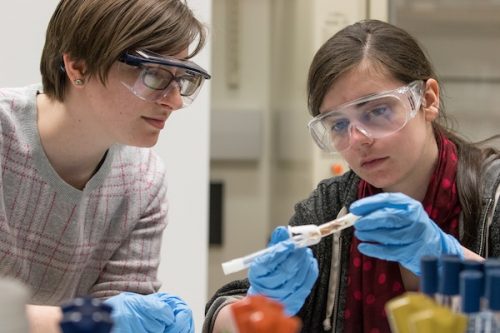
Stockton University students Valkyrie Falciani and Danielle Ertz setting up a preliminary experiment with flax seeds in an FME.
Proposal Summary:
The human race is moving closer and closer to long term space travel to explore beyond our blue planet and this has posed some interesting challenges. One of the main problems we face is growing our own long lasting food supply in microgravity. While a lot of work has been done to study plant growth in space, we believe that agriculture in microgravity can be improved by studying mycorrhizae: the mutualist relationship between plants and fungi. This relationship has been shown, on Earth, to greatly increase the productivity of agriculturally important plant species. We propose to study this by using the type 3 FME Mini Lab to combine Glomus invermaium, a species of arbuscular mycorrhizal fungus, and Linum usitatissimum, or flax, on the International Space Station (ISS), and then compare the results to a ground truth experiment. No matter the outcome of the experiment there is valuable information that we can gain that will aid space travel in the future.
HONORABLE MENTION FINALISTS:
The Effect of Microgravity on Gene Expression of Anabaena variabilis
Grade 14, Stockton University
Principal Investigator: Ariel Petchel
Teacher Facilitator: Dr. Tara Luke
Proposal Summary:
Cyanobacteria can be used in many space-related applications; however, they are particularly useful for oxygen-production in bioregenerative life support systems in the case of an emergency (Olsson-Francis, de la Torre, Towner, & Cockell, 2009, p. 566). It is currently unknown if cyanobacteria’s gene expression is altered in microgravity. This question is pertinent because if gene expression is increased or decreased in photosynthesis-related genes, it could improve or degrade cyanobacteria’s effectiveness to produce oxygen in such situations. It has already been proven by Olsson-Francis et al. that Anabaena cylindrica akinetes can survive in low Earth orbit. Therefore, tests on gene expression are the natural next step. Due to sunlight-related restrictions, Anabaena variabilis ATCC 29413, a cyanobacterium that can grow in complete darkness, will be used in this experiment. Growth will be induced in the NanoRack via a growth medium shortly after arrival on the ISS and will be paused using an RNA preservative shortly before departure back to Earth. A ground truth experiment will be conducted on Earth from the same batch of cyanobacteria. Afterwards, gene expression will be analyzed using transcriptomics with a next generation sequencer, the Ion PGM System, to see if microgravity affects gene expression in cyanobacteria.
The Effect of Microgravity on the Autophagy Process of Saccharomyces cerevisiae or Brewer’s Yeast
Grade 15, Stockton University
Co-Principal Investigators: Mushfiq Ahmed Atul, Kayla Hope
Collaborator: Isabelle Mustaro
Teacher Facilitator: Jason Shulman
Proposal Summary:
Our experiment attempts to understand how autophagy, a process of recycling cellular organelles in eukaryotes, is affected by microgravity in saccharomyces cerevisiae (brewer’s yeast). The importance of autophagy in cells have only been recently realized and it has the potential of promoting or inhibiting cancer in human cells. It has also been linked to Parkinson’s disease and diabetes. Utilizing yeast to study autophagy has never been performed in space and hence we have carefully optimized the experiment in order to generate as much data as possible. We are using yeast since it is an excellent model for the human cells and that the mechanisms of autophagy are conserved between yeast cells and higher eukaryotes. Furthermore, it is easy to study a single celled organism compared to the complications that may arise with a multicellular subject. We will be keeping 5 controls on Earth which will be exposed to the same environmental conditions as their counterparts in the (International Space Station) ISS. The only variable will be the pull of gravity. The sample in ISS will experience microgravity while the samples on Earth will be subjected to the usual gravitational field strength of 9.8 N/kg. We will be using a Type 3 FME with yeast in the middle compartment, growth medium for yeast and Rapamycin antibiotic in Volume 1, and RNAlater solution in Volume 3. We hypothesize that the experiment on ISS will show deviations from the samples on Earth.
13. Springfield, New Jersey
Jump to Springfield’s Community Profile
SELECTED FOR FLIGHT:
Which Type of Lettuce Seed Germinates Best in Microgravity
Grade 7, Florence. M. Gaudineer Middle School, Springfield Public Schools
Co-Principal Investigators: Elisha Acosta, Maxwell Levy, Ian McLeer, Rudraksha Vyas
Teacher Facilitator: Alison Gillen
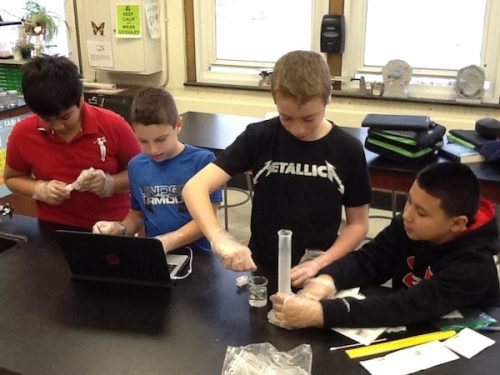
7th graders Rudraksha Vyas, Maxwell Levy, Ian McLeer, and Elisha Acosta work to improve how to keep different types of lettuce seeds separate from one another in the FME.
Proposal Summary:
Our question is, which type of lettuce grows best with the effect of microgravity? We decided to test the effects of lettuce in microgravity because, many psychiatrists have recommended eating fresh foods to remind the astronauts of home. Another reason is that fresh foods are helpful to the health of astronauts on the ISS, and lettuce is the perfect medium. There are many types of lettuce seeds and we would like to experiment on 3 to 4 types of them. Our seed types we will be experimenting on are, Grand Rapids, Iceberg, Loose Leaf Blend and Black Seeded Simpson. Our experiment will help scientists learn about how fresh lettuce can be grown and eaten in space. It can help them do further research about how other fresh fruits and vegetables, and regular food that is not dried and packed in general, can be grown, eaten and used in microgravity. This information can be used to help us settle on Mars, but we have to start small. We tested the seeds with and without seed tape and there is no difference. We have one type of all the seeds just wrapped in paper towels, and we have the other group in our homemade seed tape. The type of FME we will be using is type 3. We will be using the type 3 FME because it will give equal space to water, seeds and a concentrated salt solution. The salt solution will be used to kill the plants after they germinate.
HONORABLE MENTION FINALISTS:
What Effect does Microgravity have on the Formation of Concrete using Meteorite Material?
Grades 11-12, Jonathan Dayton High School, Springfield Public Schools
Co-Principal Investigators: Josh Damast, Adam Gelo, Isaiah Gorham, Daniel Greiss
Teacher Facilitator: Bryan Davison
Proposal Summary:
Our experiment for the SSEP project will test the effects that microgravity has on the formation of concrete made with meteorite materials. Regular concrete is made from mixing cement with a rock-like material (aggregate) such as sand and gravel followed by adding water. Our idea, however, is to create concrete by replacing the usual rock-based aggregate needed to make
concrete with meteorites. If our hypothesis is correct and we are successful in doing so, we can help provide a cheaper and more convenient option for transporting building material to space. Large quantities of gravel and sand would no longer need to be transported, and the cost of sending the materials to space would be reduced drastically.
The Effects on Wheat Grown in Microgravity
Grade 9, Jonathan Dayton High School, Springfield Public Schools
Principal Investigator: Jessica Miller
Co-Investigators: Andy Grafanakis, Aren Mortenson
Teacher Facilitator: Irene Ornovitz
Proposal Summary:
In our experiment we plan to test the growth of wheat kernels in microgravity. This will impact future space exploration because it will serve as a source of food and nutrients. Furthermore, it will allow scientists to infer whether or not it is possible to grow food that allows
life to survive in space. We chose wheat because it can produce carbohydrates such as bread that provide energy. This energy is important because the effects of microgravity may put a lot of pressure on the residents in space such as those who live on Mars. The suit weighs a significant amount making it hard to move, and the body has to do a lot for itself due to the lack of gravity. This burns a majority of the astronauts carbohydrate input and forces them to eat more. To set up our experiment, we will use the fluid mixture enclosure with three compartments; one will be filled with 5 wheat kernels, the other will be filled with agar, and the last will be filled with a fixative to stop the growth of the wheat. We hope to see that after the time in microgravity that the wheat kernels had grown into a usable, significant size. When the kernels grow, it is essential that the kernels germinate to show that it is possible for the wheat kernels to develop in microgravity.
14. Waterford, New Jersey
Jump to Waterford’s Community Profile
SELECTED FOR FLIGHT:
Galaxy Eggplants
Grade 6, Waterford Elementary School, Waterford Township School District
Co-Principal Investigators: Ava Brennan, Marley Brennan, Hailey Reese
Co-Investigators: Abigail Baines, Angelina Mott
Teacher Facilitator: Debra A. Parker
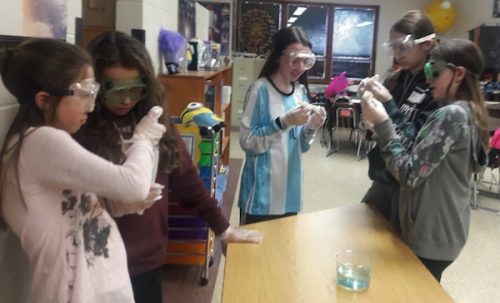
The girls are studying the trial experiments of the eggplant seeds and gibberellic acid solution in their FME.
Proposal Summary:
Our experiment is to see how microgravity affects the germination of a eggplant seed. The normal germination time of the eggplant on Earth is seven to fourteen days (one or two weeks). We are also attempting to find the effects of the ozone layer of the atmosphere on plant growth. Our hypothesis is, without the ozone layer, the seed will sprout faster. We also believe that the germination will be impacted by microgravity. This experiment includes four materials: one eggplant seed, a piece of cotton 0.1x 0.1 cm², gibberellic acid, and distilled water. We will examine the effects of microgravity on the seed by measuring the size of sprout from space and the sprout on Earth.
HONORABLE MENTION FINALIST:
Perfect Crystals in Space
Grade 6, Waterford Elementary School, Waterford Township School District
Co-Principal Investigators: Ryan Long, Kevin Watson
Co-Investigators: Guy DeFabrites, Matthew DeStefano, Ayden Lucas
Teacher Facilitator: Debra A. Parker
Proposal Summary:
For our SSEP experiment our group would like to figure out if we can grow
a more perfect crystal by growing one seed on Earth and compare it to a seed grown from the same solution in a microgravity environment. For our hypothesis, we would like to know if we can grow a more pure and perfect crystal in a microgravity environment than on Earth. The materials our group will be using to conduct this experiment is the following: Potassium
Aluminum Sulfate (potassium alum) and water. This experiment is to see how crystals will grow differently in a microgravity environment than on Earth. We will add one drop of blue food dye to give the crystals coloring.
15. Rochester, New York
Jump to Rochester’s Community Profile
SELECTED FOR FLIGHT:
The Effect of Microgravity on the Deterioration of Chlorophyll in Phytoplankton
Grades 11-12, East High School, Rochester City School District
Principal Investigator: De’Aunte Johnson
Investigator: Binti Mohamad
Collaborator: Tailor Davis
Teacher Facilitator: Mary Courtney
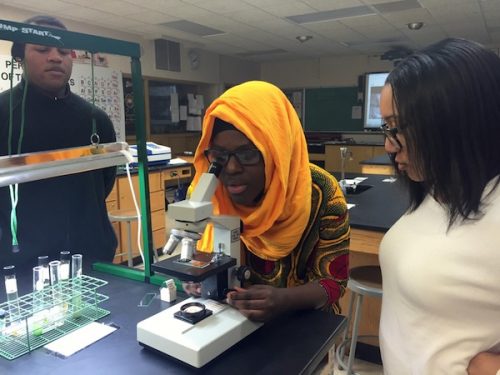
Binti Mohamed (center) views live Spirulina samples through the microscope as De’aunte Johnson (left) and Tailor Davis (right) await their turns.
Proposal Summary:
The experiment is designed to test how microgravity conditions affect phytoplankton chlorophyll deterioration rates. Phytoplankton are proposed to be used as the specimen to answer the question because microscopic marine plants are small enough to fit in an FME. Using an FME type I, samples will be in one volume, premixed. An abundant source of nutrients will make conditions as normal as possible. A spectrometer will be used to measure chlorophyll levels. The phytoplankton will not be allowed any sunlight or artificial light, only nutrients from a cocktail that is considered favorable for phytoplankton to survive. No astronaut interaction is necessary as this experiment is designed to measure the change in chlorophyll levels due to the microgravity environment. Initial chlorophyll levels will be measured prior to the sample being sent into space while a second sample is kept on earth under similar storage conditions. The hypothesis is that there will be a difference between the decay rates of chlorophyll in microgravity compared to gravity (earth) conditions.
HONORABLE MENTION FINALISTS:
The Effect of Microgravity on Glioblastoma Cells (Rat Astrocytes)
Grade 10, East High School, Rochester City School District
Principal Investigator: Shantanique Simmons
Teacher Facilitator: Mary Courtney
Proposal Summary:
Researchers at Duke University’s Medical Center’s Preston Robert Tisch Brain Tumor Center have been studying how the synthetic polio they developed can reduce the size and stop growth of glioblastomas in patients. Glioblastoma multiforme (GBM) is the most common and aggressive of the primary brain tumors. These tumors are usually highly malignant (cancerous) because the cells reproduce quickly and they are supported by a large network of blood vessels. The synthetic nonpathogenic poliovirus (PVS-RIPO) in put directly into a patient’s tumor and it goes to work killing the cancer cells. It also promotes immune response to cancer in patients to help shrink and keep cancer cells away. So far the virus has only been tested against
glioblastoma patients’ cancers with promising results, but researcher think it will work on other cancers too. Glioblastomas have been shrunk and growth slowed with the synthetic polio treatment. NASA has been studying the treatment of cancer cells in space using microgravity affects the way cancer cells grow in space. Cancer cells tend to grow in sheets rather than in lumps in zero gravity. This makes it easier to treat the cancer cells. Combining these two research findings would help give the answer to the question, does microgravity or zero gravity promote better results using the synthetic poliovirus to shrink or kill cancer cells.
Osteoblast in Space
Grade 12, East High School, Rochester City School District
Principal Investigator: Shirley C. Smith
Teacher Facilitator: Mary Courtney
Proposal Summary:
I am sending a sample of mouse osteoblasts into microgravity to see if the cells will divide more slowly than usual. I will be using the type 3 FME setup. In chamber 1 and 2 there will be mouse osteoblasts; and the third chamber will contain 10% neutral buffered formalin (NBF). The first chamber of osteoblasts will go through the whole trip without being touched. The osteoblasts in the second chamber will be deactivated with the neural buffered formalin from the third chamber the day before descent. When the cells return I will be comparing cell division in both chambers 1 and 2 to the control sample kept here on Earth. The 2nd chamber I will compare to the control sample to determine what genes were turned on/off. If my hypothesis is correct I will determine if the genes in osteoblast are present in cancer cells. I would like to further my experiment more by trying to determine a way to turn on/off the gene in the cancer cell but I am aware it takes years to do those kind of things.
16. Concord, North Carolina
Jump to Concord’s Community Profile
SELECTED FOR FLIGHT:
Gravitropism of Radish Seeds in Microgravity
Grade 7, J.N. Fries Magnet Middle School, Cabarrus County Schools
Co-Principal Investigators: Sreenidhi Elayaperumal, Zayneb Shaikh, Paige Starnes
Advisors: Amy Bowman, Todd Erickson
Teacher Facilitator: Paul Fields
Proposal Summary:
The purpose of our experiment is to find the effects of varied gravitropism during germination of radish seeds. Gravitropism is a plant’s response to the stimuli of gravity. The roots grow along with gravity, and the shoots grow against it. Gravitropism can affect the development of a seedling, contributing to aspects such the length and direction of growth of the shoot and roots. Space has a varying degree of gravity in contrast to the constant gravitational pull on earth, therefore, the seedlings grown in space may develop differently from ones grown on Earth. The direction of growth in the plant may be different, and the roots and shoot may have varying proportions. This experiment has importance, since learning about the development and growth of plants in space can one day have value, when more contributions are made to explore agriculture in space. If the gravity in space is not suitable for plant growth, we need to find a way to modify the plant or the environment in order to grow crops in space. In our experiment, we will be observing the germination of radish seeds in gravity and microgravity, to see if there is a difference between the two seedlings. We hypothesize that the seed in microgravity will have slower radicle and primary root development, but faster epicotyl and shoot development. The seedling from space may also grow in erratic directions. We hope to gain new knowledge from this experiment.
HONORABLE MENTION FINALISTS:
The Effect of Microgravity on the Germination of a Radish Seed in a Mixture of Crushed Penicillin and Sterilized Soil
Grades 6-8, J.N. Fries Magnet Middle School, Cabarrus County Schools
Co-Principal Investigators: Kripa Patel, Jonathan Rogers, Claire Sexton, Mary Swayze
Advisor: Lauren Duncan
Teacher Facilitator: Margaret Gladin
Proposal Summary:
Our project, The Effect of Microgravity on the Germination of a Radish Seed in a Mixture of Crushed Penicillin and Sterilized Soil, is a project where we test how quickly a radish seed, or a Raphanis Sativus, germinates in crushed Penicillin and sterilized soil. Basically, we are comparing the germination rate of the radish seed on Earth compared to the germination rate in microgravity. Our project will consist of two experiments, one on Earth and one in microgravity. We will then compare and analyze the results of our experiments after both components are finished. For our actual experiment, we will have three separate enclosed spaces in the tubes. One will be for our distilled water, sterilized soil, and crushed Penicillin, one for our radish seed, and the final space for our Formalin Fixture. We included Penicillin to see its effect on the germination of a radish seed, and to see how certain antibiotics affect the germination of a radish seed. We decided on this experiment because it can show how microgravity affects the germination rate, which for future generations will be important if in the future we begin to try to grow crops on places other than Earth, such as a Mars Base or the ISS. We hope our experiment can help future generations undertake the experiment of growing crops on places other than Earth, which can help space exploration and even eventually colonization in space.
Properties of Calcium Carbonate when Exposed to Microgravity
Grades 6-8, J.N. Fries Magnet Middle School, Cabarrus County Schools
Co-Principal Investigators: Cade Azzariti, Kate Grundman, Jakob Johnson, Mastawal Tirfe
Advisor: Jonathan Coons
Teacher Facilitator: Frank LaRoche
Proposal Summary:
Our question is can calcium carbonate be made in space and if possible, does it keep the same chemical properties as when it’s made on Earth? We’ll send the substances needed to make calcium carbonate up and see the difference between Earth-made and space-made. Calcium carbonate is “a white, insoluble solid occurring naturally as chalk, limestone, marble, and calcite, and forming mollusk shells and stony corals” (What Is Calcium Carbonate? –
Industrial Minerals Association – North America. N.p., n.d. Web. 18 Oct. 2016). Calcium carbonate, if not made correctly, could lose some of its good qualities. Calcium carbonate is lightweight, it can block radiation, and it can also be used as a building material. If these qualities are lost, calcium carbonate would be rendered almost completely useless, and there
would be no reason for creating it. We need to see if it would lose these qualities in space so we know if it should strictly be made on Earth. In the experiment that we are doing, we’ll combine the first and second substances, carbon dioxide and calcium oxide, and it will hopefully make calcium carbonate. When the tube is back to us after the experiment is over, we’ll examine the similarities and differences of the calcium carbonate made in space and the calcium carbonate that we’ve used as a constant. This information will help scientists know if calcium carbonate is a good building material for constructing or for protection against radiation when made in space.
17. Knox County, Tennessee
Jump to Knox County’s Community Profile
SELECTED FOR FLIGHT:
The Removal of Blue-Green Algae Cells from Water in a Microgravity Environment
Grade 8, Vine Middle Magnet School, Knox County Schools
Co-Principal Investigators: Chandler Arnold, Sude Buyuktazeler, Shukurani Cimpaye, Jairo Tomas, Tayon Wright
Teacher Facilitators: Melody Hawkins, Dr. Rich McKinney
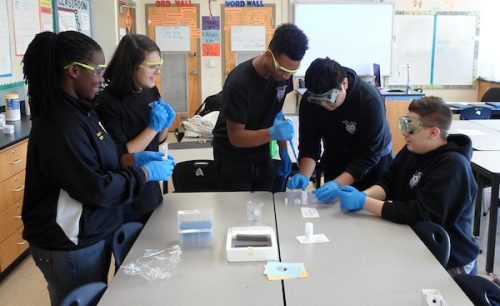
Testing the Effectiveness of Colloidal Silver on Staphylococcus Epidermis Type of Bacterial Conjunctivitis as compared to Zylet.
Proposal Summary:
Blue-Green algae are a form of cyanobacteria, which are found in small bodies of water such as rivers lakes and ponds. Blue-Green algae contain toxins, which can be harmful toward people. Blue-green algae cause three different types of toxins, which are neurotoxins, hepatotoxins, and dermatoxins. Neurotoxins affect our nervous system, hepatotoxins affect our liver and how it functions, and dermatoxins irritate our skin. Some of these can even cause death (Oregon Department of Human Services: Public Health Division, 2010). Our topic will focus on the removal process of Blue-Green Algae using an alum and sodium aluminate mixture. This will help ensure the safety in microgravity environments and will make water safer for human consumption. We will test this by using a Type 2 FME to mix the alum and sodium aluminate with the blue-green algae water. Volume 1 will have 4.0 mL of alum and sodium aluminate mixture and volume 2 will have 5.2 mL of blue-green water. The data will be collected based on production of the floc. We hypothesize that the alum will block the phosphorus from feeding the bacteria, thus presenting the bacteria from growing. We anticipate that there may be some difficulties with the mixtures reacting in a microgravity environment due the lack of gravity.
HONORABLE MENTION FINALIST:
Testing the Effectiveness of Colloidal Silver on Staphylococcus Epidermis Type of Bacterial Conjunctivitis as compared to Zylet
Grades 6-9, Bearden Middle School, Knox County Schools
Co-Principal Investigators: Duncan Arnold, Greta Burns, Moamen Emara, Alex Hoffman, Elise Kersch, Jack Lathrop, James Pierce, Mauricio Sanchez, Riley Speas, Katherine Trent, William Walker
Teacher Facilitators: Kayla Canario, Virginia Brown
Proposal Summary:
Bacterial conjunctivitis is a common infection and can affect astronauts during space travel. As space travel progresses, bacterial conjunctivitis could become an uncontrollable problem. We have partially addressed this problem by finding out if bacterial conjunctivitis will be affected by a normal antibiotic treatment in a previous proposal. In this experiment, we hope to test a homeopathic treatment to see if it is as effective in treating the bacteria as the prescription medicine. Understanding the growth and treatment will not only allow us to effectively treat future infections, but will have implications of treating other bacterial infections in space as well.
18. Burleson, Texas
Jump to Burleson’s Community Profile
SELECTED FOR FLIGHT:
Concrete Compressive Strength
Grade 6, STEAM Middle School, Burleson Independent School District
Co-Principal Investigators: Danyel Archuleta, Mayleia Parker, Cole Rose, Christian Steele
Teacher Facilitator: Mindy Quisenberry
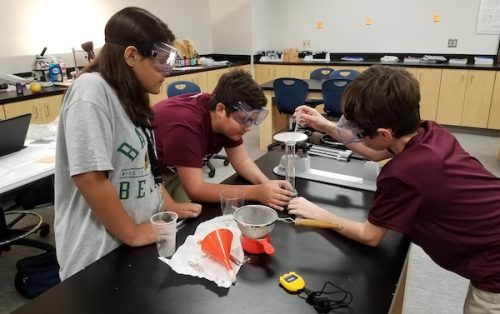
Danyel Archuleta, Christian Steele, and Cole Rose, 6th grade Student Researchers from Burleson ISD, work to determine the best concrete/water ratios for their experiment.
Proposal Summary:
Our experiment is a force reading and analysis of concrete. We will make concrete in both space and on earth. When the concrete returns to earth, a microscope will be used, as well as a force gauge, to examine the differences between the sample formed in microgravity and the samplevformed on Earth. This experiment is also pertinent to future missions to colonize Mars – our neighboring planet. Concrete is a common construction material used on Earth to build houses and habitats. What, if any, are the effects of microgravity on the structural integrity of concrete? Although concrete gets warm it is a small enough sample so it will not affect any other experiments.
HONORABLE MENTION FINALISTS:
The Spectacular Sponge
Grade 6, Nick Kerr Middle School, Burleson Independent School District
Co-Principal Investigators: Abby Allen, Bailey Schaefer, Katie Shue, Taylor Walker
Teacher Facilitator: Allison Buckingham
Proposal Summary:
Our question is “Will a Carbon Nanotube Sponge absorb oil out of water in microgravity?” Our SSEP team was inspired by a video of professors from Rice University explaining the unique sponge. On Earth, the Carbon Nanotube Sponge will only absorb oil, not water. The benefit of our experiment is so if an oil leak occurred on the ISS, the astronauts can apply the sponges to the surface and absorb the oil. We contacted Rice University and requested if they would lend us a Carbon Nanotube Sponge for our experiment. In our experiment, a Type 2 FME will be used and Crisco canola oil will be substituted for mechanical oil. Other needed materials include a Carbon Nanotube Sponge, Dasani bottled water, graduated cylinder, and an eyedropper. The Crisco canola oil and Dasani bottled water will be in Volume 1 and the Carbon Nanotube Sponge will be in Volume 2. It takes about a week to reach the ISS and once the FME gets to the ISS the astronauts will follow the procedure information. The astronauts will Shake the FME before opening the clamp. Next they will open the clamp between the Carbon Nanotube Sponge, the Dasani bottled water, and Crisco canola oil mixture. The astronauts will wait until U-14 then re-clamp Clamp A. We will perform these same steps on Earth and measure how much oil the Carbon Nanotube Sponge absorbs with the graduated cylinder. This is a fun and interesting experiment that has never been done before in microgravity.
The Invertebrate Issue
Grade 6, STEAM Middle School, Burleson Independent School District
Principal Investigator: Caleb Quisenberry
Investigator: Philip Hamilton
Collaborator: Billy Ward
Advisor: Stacy Hughes
Teacher Facilitator: Mindy Quisenberry
Proposal Summary:
We propose to answer the question: How does the nervous system supportive structure of Artemia Salina react in a microgravity environment? This information will help us to know if the supportive structures and/or spines of animals and humans do expand and make the living creature taller. If this does happen then we could potentially help astronauts in future space travel. If the supportive structure expansion does not become an issue then the space travelers would not have to worry about excruciating neck and back pain. In a microgravity environment the human spine tends to expand and the cartilage holding the spine stretches, leading to neck pain. This body modification also wastes time that the astronauts could be using to conduct experiments and test ours. If they have to spend time to deal with that pain, then they could do their job. In our test, we will be simulating how the Brine Shrimp’s nervous system supportive structure (Artemia Salina) are affected by living in a microgravity for the time that they are in the ISS. We will direct the astronauts to unclamp the clamp that separates the Artemia Salina eggs from the water. The Shrimp will then hatch within 24 hours. We hope to see the same reaction to the Brine Shrimp’s nervous system supportive structure as from the human spine. The result of this experiment might help us to fix the problem of the human spine in microgravity and save so much time and pain the astronauts would have to go through.
19. Lewisville, Texas
Jump to Lewisville’s Community Profile
SELECTED FOR FLIGHT:
Effects of Microgravity on Listeria innocua Biofilm Formation
Grades 9-11, iSchool High STEM, Texas College Preparatory Academics
Principal Investigator: Andrew Zhao
Co-Investigators: Stephanie Do, Logan Worthington
Teacher Facilitator: Laurie Bailey
Proposal Summary:
Listeria biofilms have a paramount effect on society, causing an estimated 1600 illnesses and 260 deaths annually in the United States alone (Scallan, et al). Biofilms are created when a colony of bacteria is exposed to an aqueous surface. This causes the bacteria to form natural polymers of high molecular weight and sugary molecular strands collectively known as EPS
(Extracellular Polymeric Substances) (Costerton, et al). In order to understand the effects of microgravity on L. monocytogenes biofilm, in connection to the food industry, the experiment will consist of having L. innocua cells exposed to two approved food contact surfaces to form a biofilm: polyethylene strips, and grade 302/304 stainless steel wires. The species of bacteria that will be tested in this experiment is Listeria innocua, a non-pathogenic substitute for the more commonly known species of Listeria monocytogenes (Friedly, et al). The experiment will be conducted inside a Type 2 FME mini lab, with polyethylene strips, stainless steel wires, and trypticase soy broth in volume two and a colony of 10,000 L. innocua cells on a sterile bead in volume one. The results of the experiment will be compared to an identical ground experiment and analyzed with a confocal microscope to observe the density, three-dimensional structure, and thickness of the L. innocua biofilms. The knowledge gained from this experiment could reduce the number of food poisoning cases, bacterial infection cases on Earth, improve understanding of biofilm sanitization, and aid in the design of equipment and spacecraft (Mclean, et al).
HONORABLE MENTION FINALISTS:
The Extraction of Copper from Copper Sulfate Solution
Grades 9-11, iSchool Lewisville STEM Academy, Texas College Preparatory Academics
Principal Investigator: Kylie Deboef
Co-Investigators: Christopher Hartigan, Sarah Metzger
Teacher Facilitator: Laurie Bailey
Proposal Summary:
The group will be exploring the effects of microgravity on single replacement reactions. The question the group is posed to answer is that, if under microgravity, can copper still be extracted from a solution of copper sulfate using aluminum? Even with the use of a very small percentage of copper sulfate in a solution (1%), the experiment has proven viable on earth. They will first combine copper sulfate and water, then add aluminum, and finally they will drain the water from the product. Answering the question posed above will help scientists gain valuable insight into chemical reactions in microgravity. As copper is a diminishing resource on earth it is important that people extract as much from it as possible. Also, because copper is a necessary material on space flights, it should be easily accessible without using too much storage. Overall, this experiment is simple, yet beneficial, and should be chosen to fly in microgravity.
Microgravity’s Effect on the Osmosis and Soil Creation of Moss
Grades 9-11, iSchool High STEM Academy, Texas College Preparatory Academics
Principal Investigator: Jais Starks
Co-Investigators: Jessica Rosales, Cameron Schoenfield
Teacher Facilitator: Laurie Bailey
Proposal Summary:
What does microgravity do to the osmosis and soil creation properties of moss? Osmosis is the ability of plant cells to distribute water evenly from inside and outside itself. It gives moss the ability to obtain water for itself. Moss is a pioneer species that can survive harsh conditions with minimal assistance to sustain it. It can erode rocks into mineral rich soil and produce oxygen from carbon dioxide in the atmosphere. This means that if someone were to put moss on a planet, such as Mars, which has an atmosphere that contains high levels of carbon dioxide, plants like moss would thrive in these conditions and spread enough to create soil and support other plant types. With enough moss to get other plants to survive, the viability of Mars to be a place of settlement could increase dramatically. Though the moss breaking down the rock into soil would take hundreds of years to completely transform even a part of Mars’ surface, it would help colonization in the long run.
20. Pharr, Texas
Jump to Pharr’s Community Profile
SELECTED FOR FLIGHT:
How does Microgravity Effect the Growth of an Allium cepa Seed?
Grade 11, Thomas Jefferson High School, Pharr-San Juan-Alamo ISD
Co-Principal Investigators: Kristina Evasco, Kirk Miller, Emiliano Nuno, Anna Pineda, Abigail Salazar
Teacher Facilitator: Andrew Martinez
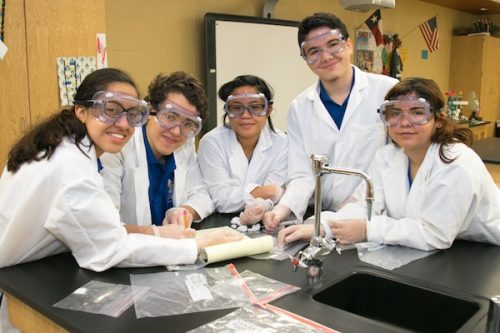
SSEP Student Team from PSJA Thomas Jefferson T-STEM Early College High School runs tests to analyze how microgravity affects the growth of Allium cepa seeds.
Proposal Summary:
We are conducting this experiment to determine how microgravity effects the growth of a Allium cepa seed. The experiment uses deionized water, cotton balls, and dry Allium cepa seeds. We will use a Type 3 FME. Volume 1 will have one cotton ball and ten dry Allium cepa seeds that will be placed in the cotton ball. Volume 2 will be filled with 1 mL of distilled water. Volume 3 will contain a selected fixative, Formalin, to stop the growth process. During the first week of the arrival of the space shuttle at the ISS, clamp A will be unclamped, releasing water to begin the germination process. In the week prior to undocking, clamp B will be unclamped to release the fixative and to preserve the experiment in microgravity. Upon return of the space shuttle, observations of the seeds will be done and data will be collected. Observations will include length of stem, observations of roots and stems, and stage of growth. If it is determined that microgravity allows for optimal seed growth, plants could be grown as a renewable food source in space. Plants could also help introduce new oxygen into the space vehicles. Studying gravitropism will also help to understand how to grow plants in space and find optimal growth. Food supplies and nutrients will be less of an issue. Future space travelers will be able to travel farther in the and live in space stations for longer periods of time if they travel with their own food.
HONORABLE MENTION FINALISTS:
Effects of Microgravity on Saccharomyces Cerevisiae Growth
Grade 11, PSJA Thomas Jefferson T-STEM Early College High School, Pharr-San Juan-Alamo ISD
Co-Principal Investigators: Miguel Garcia, Luis Gonzalez, Juan Mejia, Geremy Quintanilla
Teacher Facilitator: Natasha Quailes
Proposal Summary:
Our question is, does microgravity affect the growth of Brewer’s yeast (saccharomyces cerevisiae)? This yeast is frequently used as a source of vitamins and minerals and is rich in B vitamins, chromium and selenium. Since the yeast can grow in anaerobium, it is possible to culture it in space. The growth of yeasts in microgravity would allow for scientists to learn more of the forms of nutrition without the influence of gravity. The knowledge that can be gained would be useful because brewers yeast can be used to form bread; within the bread would be a very important source of healthy whole grain carbohydrates necessary for humans to complete biological processes needed for survival. Saccharomyces cerevisiae’s rich source of chromium may assist in maintaining normal blood sugar levels and its abundance of selenium will help fight free radicals, damaging particles in the body. This could be beneficial for the health of astronauts. The materials that are needed inside a type 2 FME are crucial for the yeast to grow. In volume 1 we propose to have the Brewer’s yeast. In volume 2 we propose 1.28 mL glucose, glycerol, and salts which contain nitrogen, phosphorous, and trace metals. When the type 2 FME is unclamped, the release of the growth solution will enable the saccharomyces cerevisiae to grow. We have learned from previous experiments by scientists and from thorough research, that glucose and the required salts are a substantial solution for growing saccharomyces cerevisiae.
Does Microgravity Affect the Rate of Binary Fission in Paramecium caudatum?
Grades 10-11, PSJA Thomas Jefferson T-STEM Early College High School, Pharr-San Juan-Alamo ISD
Co-Principal Investigators: Kaelin Cabrera, Abigail Salazar
Teacher Facilitator: Natasha Quailes
Proposal Summary:
Our proposed question of experimentation is, does microgravity affect the rate of binary fission in paramecium caudatum? We decided to research binary fission to observe if microgravity affects in any manner the way or the rate at which the genetic material replicates. Paramecium caudatum is often the subject of wide research fields due to the ease of growth. We have decided to use paramecium caudatum because of the fact that this special heterotroph lives in aquatic habitats and replicates by the process of binary fission. This protozoan supports itself by consuming bacteria, algae, yeast, and other protists. With the increase of binary fission it may result in findings of a new manner of controlling certain harmful bacterial production. Should binary fission decrease, this may provide a way to prevent rapid production of paramecium caudatum in freshwater sources that may otherwise be saturated with this organisms.
21. San Antonio, Texas
Jump to San Antonio’s Community Profile
SELECTED FOR FLIGHT:
Chytrid Frog Fungus Survival in Space
Grade 8, J.L. Matthey Middle School, Southside ISD
Co-Principal Investigators: Carlos Gonzalez, Neco Jimenez, Justin Kenkeo
Teacher Facilitator: Robert W. Bryson, Jr.
Proposal Summary:
The chytrid frog fungus, Batrachochytrium dendrobatidis, is a fungus that is causing a global decline of amphibians and extinctions of some species. The fungus affects amphibians like frogs and salamanders and kills the host by infecting the layers of amphibian skin. It was discovered in 1999 but there is no cure. We believe the chytrid frog fungus will behave differently in microgravity. The life cycle of the chytrid frog fungus is complex and is composed of several different stages. Our hypothesis is that the stages of this life cycle cannot be completed in microgravity. Without feeling the force of gravity pushing down, the fungus will not know which direction to grow. If the frog fungus does not grow, then microgravity may be important to help scientists find a cure for the fungus.
HONORABLE MENTION FINALISTS:
Et tu Fungi? Effect of Microgravity on Fungal Interactions
Grades 9 and 11, Southside High School, Southside ISD
Principal Investigator: Allie Herrera
Co-Investigators: Erin Bell, Johnny Herrera, Alyssa Herrera, Derrion Sendejo
Teacher Facilitators: Christopher Strey, Samuel Ebong
Proposal Summary:
Commensalism between bacteria has traditionally been mostly studied and recorded. However, it is becoming more apparent that there are equally similar relationships between several fungi within living organisms (Qin J). Most studies have focused on bacterial interactions. So we possibly have bacteria-bacteria, bacteria-fungus, and fungus-fungus interactions. Because of all these possible interactions, it is important that the immune system be in a great working order (Brown GD). In this study, we focus on fungi and how common fungi, S. cerevisiae and C. albicans, known to be normal inhabitant of humans and other animals, interact with each other
and others while in space. Bacterial infections, especially E.coli, are recognized by the host mainly by recognizing LPS (lipopolysaccharide). LPS (or endotoxin) is the major component of the outer membrane and serves as a marker by the immune system for the detection of bacterial infection (Rosenfeld Y). Since living things have all types of microbes cohabitating and they also interact, we want to know how fungal colony would be affected by bacterial infection under microgravity. Will a disturbance in the balance between fungi affect usual activities, infection, virulence, growth rate, physiology, or morphology? Knowledge from this study will add to current understanding of how microbes coexist in microgravity and more importantly, how fungi may coexist with each other as well as other microbes in microgravity.
Space Bodies
Grade 5, Losoya Intermediate School, Southside ISD
Principal Investigator: Maximus Polendo
Co-Investigators: Angel Canada, Stephen Milaeger, Jackie Quinonez
Teacher Facilitators: Julianna Trevino, MaryLou Ramirez
Proposal Summary:
The purpose of this proposal is to better understand how microgravity affects the symbiotic relationship between two bacteria, specifically E. coli and Lactobacillus. Having been functioning together in perfect harmony for millions of years, we are curious to see if this
relationship will continue or alter with less gravity. There are studies relating the interactions between the two bacteria (probiotic) under normal Earth gravity (Razzak MSA 2011, Canny, G. O. 2008 ). If gravity is taken away from the equation, would the two bacteria still have the relationship they do on Earth? This research enables us to comprehend how mixtures and
interactions of two different bacteria may be used to understand relationships under microgravity. We believe that learning such relationship can be used to find ways to design treatments that may possibly save many lives on Earth. Altogether, we will have two type 3 FME mini-labs that are prepared exactly the same. To minimize error, both tubes will remain identical and the experiment will begin at the same time. One will go up into space (microgravity) and the other will stay on Earth (normal gravity). Our variable is gravity, and the control is everything else involved. The analysis will take place in the lab at the University of Texas San Antonio (UTSA), where we will study the DNA of both E. coli and Lactobacillus, as well cell morphology and counts.
